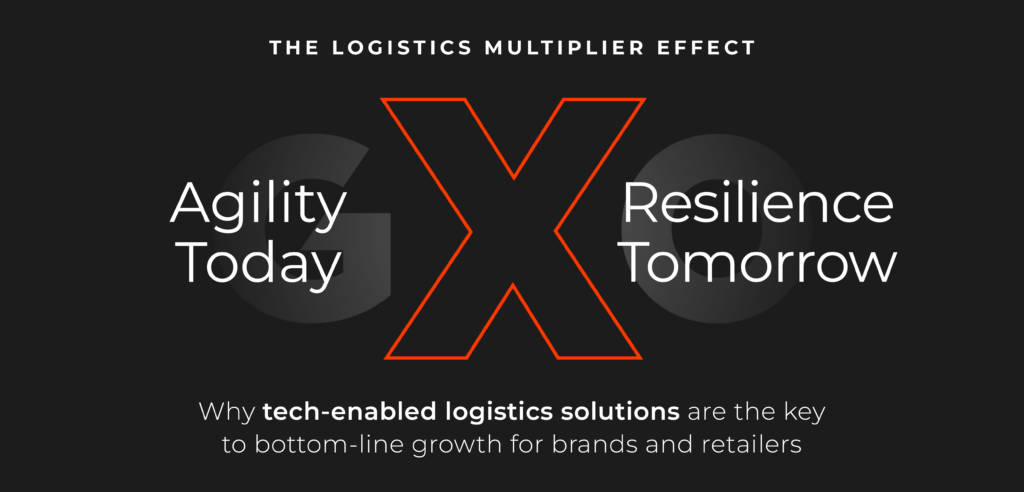
Near-term Agility X Long-term Resilience
Where we are today
Over the past several years, the role of technology and automation in logistics has evolved rapidly in response to macroeconomic and commercial shifts. The pandemic spurred interest and investment in large-scale automation to address increased demand and extreme volume volatility, but in the race for advanced automation, many 3PLs and automation providers implemented solutions that weren’t tailored to the unique business needs of their customers.
Now, companies are facing increasing pressures from rising costs, workforce management challenges and sustainability demands. As they turn to 3PLs to help them implement technology to overcome these hurdles, brands have rightly become more intentional and diligent in evaluating the role of, and best partners for, outsourcing logistics. The risks of selecting a partner or a technology that is incompatible with either current operational needs or long-term strategy is daunting: tech obsolescence is a risk, and operational inefficiency due to an inflexible automation strategy is an even greater one.
The horizon
Today, investing in a tech-enabled logistics solution isn’t a choice—it’s a necessity. A recent McKinsey survey of 250 logistics leaders found that they’re moving beyond foundational technologies requiring significant systems integrations to leading-edge solutions. Of the group of leaders surveyed, 93% said they plan to maintain or increase their technology spending— including in robotics, digital twins, real-time analytics and AI—over the next three years.
93%
of logistics leaders plan to maintain or increase their technology spend in key categories, including robotics, digital twins, real-time analytics and AI.

Ahora es el momento
We’re nearing an inflection point where any brand that isn’t on a logistics transformation journey will face existential problems. Tech advancements, combined with the increasing need for flexibility and data-driven decision-making, mean that failure to commit to an automation roadmap today will result in competitive disadvantages over the coming years.
Companies are left to make the challenging decision between investing in technology for near-term problem solving or long-term resilience and competitive relevance. We say: do both.
In this report, we explore today’s rapidly changing business landscape, the technology that’s helping organizations evolve and what to consider when evaluating tech investments. We also demonstrate how, when done correctly, tech-enabled logistics solutions won’t just help you overcome challenges: they’ll completely transform the way you operate, allowing you to reach your consumers in new ways and super-charging your growth.

“The secular trends driving the logistics market are bringing us to an inflection point. Any company that is unprepared for that inflection point will be at a significant competitive disadvantage. I remember having this same discussion 10 years ago about ecommerce and omnichannel—that if companies weren’t focused on them, they weren’t going to be able to catch up. And companies that didn’t went bankrupt as a result. The same thing is going to happen here.”
– Adrian Stoch, Chief Automation Officer, GXO
Optimize Efficiency X Unleash Value
Reducing costs
The cost of doing business is rising. Brands need a logistics partner to help them streamline costs and enhance productivity through tech-enabled solutions so they can continue to deliver the best experience to their end consumers while optimizing their own businesses.
Technology and automation can materially lower operating costs in a variety of ways. For example, AI-enabled analytics can deliver demand forecasting and inventory analysis for more efficient fulfillment and reduced waste. Predictive algorithms can help improve transportation routes, reducing delivery times and transportation costs while increasing accuracy. A quick deployment of cobots, wearable scanners or vision tech can meaningfully increase processing speed with no disruption to the operation.
Multiplying cost savings with tech and automation
The combination of robotics, analytics and AI to automate fulfillment is not only driving productivity; it’s creating a multiplier effect.
GXO has successfully integrated AI with a goods-to-person robotics solution into multiple sites within our consumer division, increasing the number of barcodes scanned by around 5X per bot stop. This technology has delivered increased productivity and a significant ROI boost for the customer.
GXO is also the first logistics partner to adapt mature solutions from other sectors into the fulfillment center. For example, GXO adapted a high-volume, high-precision storage and retrieval solution that was originally developed for the pharmaceutical industry to solve an operational challenge for a consumer electronics customer.
While the financial benefits of implementing automation are compelling on their own, there’s a multiplier effect from the results that also delivers improved cycle times, service quality and workforce safety.
Macroeconomic trends: Automation maturity X The cost of the status quo
There’s a second looming inflection point, this one economic: inflation is driving operational costs up, while the cost of automation, as it matures and becomes more available, is coming down.
This means the time needed to realize ROI is shrinking. Business cases that didn’t make sense just two years ago make sense today—and the financial rationale for automation will only grow stronger.
Forward-thinking brands are anticipating this inflection point and recognizing that investments in technology and automation will position them to scale their growth for years to come.
Empower Employees X Boost Productivity
The capacity shift
Workforce management, from recruiting and training talent to retaining and motivating teams, is growing increasingly complex. Today’s workforce is ever-changing, creating difficulty for supply chain leaders to boost productivity. A recent Gartner study found that productivity improvement is the top reason brands are investing in supply chain technology, outpacing other factors like competitive pressures and footprint expansion.2
Advanced tech X Increased efficiency
4-6X
productivity improvement with employees supported by robots
5-7%
average labor efficiency improvement through machine learning deployment
For many years, automation in logistics was focused on repetitive, labor-intensive tasks. Today’s tech-enabled logistics solutions can address these problems and more, with self-learning cobots working alongside humans. The next phase of automation is the seamless integration of existing robotics, combined with AI apps, solving the supply chain’s most complex problems. This capacity shift will increase operational efficiency and reduce errors, enabling team members to focus on strategic and high-value-add services.
“Automation is helping solve a significant global problem: the consistently increasing need for more productivity. Global unemployment has been hovering around 5% for nearly two years, and the workforce continues to shrink. These problems aren’t going away, and automation is a primary lever to address them at scale and for the long term.”
-Adrian Stoch, Chief Automation Officer, GXO
Here are some of the warehouse technologies that are helping companies to improve productivity in their logistics operations.

Artificial intelligence
AI is changing the way we work, and logistics is no exception. In fact, 51% of supply chain leaders believe AI technologies will create a competitive advantage or disrupt their industry within the next 10 years.3 We’re still scratching the surface of what’s possible, but AI’s early applications include predicting volume flows, troubleshooting operational errors and integrating with robotics to boost productivity.
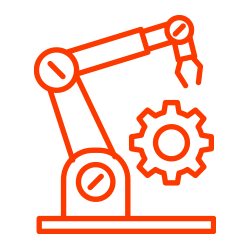
Robotics
Yes, the robots are coming—but not at the expense of humans. Rather than replacing human jobs, robots are taking on tasks like depalletizing, labelling and repalletizing packages, freeing team members to focus on strategic and value-added work. Collaborative robots, or cobots, assist team members in the fulfillment center, reducing manual activity while retaining the value of human judgment in our operations.

Integrated automation
Deployments of automated solutions are accelerating throughout the supply chain, driving productivity gains of 3-5X across picking, packing, sorting and shipping versus manual operations—which will only be enhanced by the introduction of AI and advanced robotics. Automation reduces physical demands throughout the warehouse like walking, bending and lifting, making the warehouse operate more efficiently while creating a more satisfying environment for team members.

Multiplying productivity: Focused R&D X Targeted deployment
In 2023, GXO increased its total units of warehouse automation by 50%. This included doubling active units of vision tech—a highly efficient technology that can be rolled out in operations across various verticals with low capital investment. The operations where GXO implemented vision tech saw optimized order validation with minimized errors and delivered an average margin expansion of 300 basis points.
Drive Profitability X Grow Sustainability
Becoming more sustainable
Environmental impact is an increasing governance consideration for any operating company, with carbon impact reduction, energy efficiency and waste reduction initiatives taking top priority. Questions of upstream and origin visibility for inventory, linked to quality and ethical sourcing for all merchandise, are driving a need for greater brand transparency. End-to-end supply chain traceability will become table stakes over the next decade, while unpredictable weather patterns and increasingly frequent record temperatures will continue to disrupt supply chain flows.
In addition, what were once voluntary guidelines are increasingly becoming legal requirements. It’s not enough for a company to take steps internally; they must work with suppliers and partners to ensure that Net Zero goals are met.
Beyond regulatory compliance, sustainability is more and more on the minds of consumers and investors. It’s especially influencing purchasing decisions among younger generations. Gen Z and Millennial consumers are 27% more likely to buy from a brand that they believe cares about its impact on people and the planet.4

“Increasingly, it’s not just about how much revenue you are generating. But also—how much carbon footprint are you creating? Sooner or later, that will start impacting the share valuation of companies.”
– Nizar Trigui, Chief Technology Officer, GXO

The role of logistics in sustainability
Tech-focused logistics strategies contribute to sustainability in numerous ways, both directly and indirectly. Vertically oriented automation solutions help reduce operational footprint by maximizing space utilization and capacity. Real-time analytics boost visibility and traceability, giving companies a greater understanding of the source and impact of every part of the supply chain. AI-optimized transportation routing reduces energy consumption and costs, and AI-driven recognition technology lowers waste by reducing errors and boosting quality control.
How GXO multiplies sustainability efforts
GXO has set ambitious goals for reducing its environmental impact —and we’re able to pass on that value to our customers.
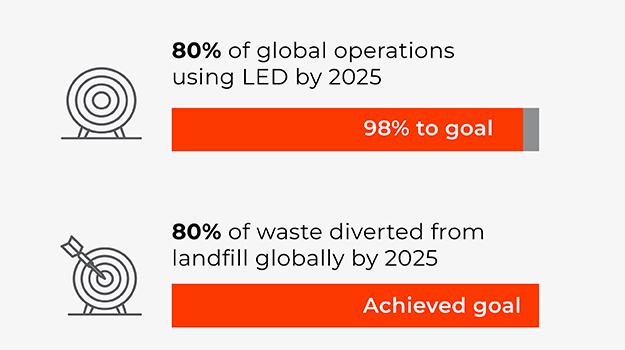

Right Approach X Right Outcomes
While the case for leading-edge logistics technology is clear, it is imperative that companies be strategic about their approach. There are a few common pitfalls to be aware of and factors to consider as you build your logistics transformation roadmap.
Innovation debt
Most companies are falling short of their potential for innovation, and that’s a cause for concern. AI and automation are today what digital transformation was 10 years ago: consider video rental or bookstore chains that didn’t adapt to, let alone get ahead of, shifting consumer behavior by embracing ecommerce and omnichannel—meanwhile, the competition did. These brands’ efforts to modernize ended up being too little too late, and they lost market share, eventually going out of business.
At the same time, the latest technology isn’t necessarily what’s right for everyone, and what’s worked for you in the past may not work for you now. A minor miscalculation in the early stages of automation planning can have major downstream impacts that set a company completely off course. You have to find the right balance and implement solutions tailored to your industry vertical and use case. GXO can help you determine what you need, because we’ve implemented hundreds of different solutions and can see what works and what doesn’t based on several factors.
Complexity
A tailored logistics solution can be extremely beneficial yet complex. Partnering with an expert that delivers fully developed and tested solutions to address unique business needs is critical.
“Complexity management through modularity is a big concept in auto manufacturing and engineering. We combine these individual technologies to create a unique solution that is more efficient, usable and better tested.”
– Nizar Trigui, Chief Technology Officer, GXO
Right-sized Solutions X Operations-first Approach
GXO takes a strategic approach to differentiating our solution offerings through technology and automation. Here’s a look at our methodology and how we leverage technologies to solve our customers’ increasingly complex supply chain problems.
A deep understanding of the challenge
Before any consideration is given to the relevance of automation—let alone which technology might be suitable—and before we design a strategic roadmap, we start with the problem.
We don’t design operations for the sake of implementing robotics; we design customized solutions that deliver optimized end-to-end product flow through the fulfillment center. We immerse ourselves in our customer’s data, with the objective of getting to know their operating and business profile as well as they do—including, critically, the degree of desire versus readiness for automation. Then, using this knowledge as the foundation, we build the journey map: a multi-year plan that addresses the customer’s current and long-term supply chain profile.
Modular solutions
Industry-wide, only 5% of warehouses have implemented automation and more advanced technologies—perhaps because they are not sure where to start.5 With GXO, it’s not an all-or-nothing approach; there’s room to operate and evolve in between. Let’s look at the different tiers of automation, and how GXO can flex its solutions to meet your goals.
Tecnología adaptativa
- Easily deployed within existing operations
- Examples include wearable vision tech, smart gloves, robotic arms and cobots
- Start up in days to weeks
- Payback period can be measured in months
Large-scale automation
- Involves end-to-end redesign of an entire warehouse
- Examples include implementation of an end-to-end process flow, with robotics executing goods-to-person fulfillment to a conveyor; conveyance routing product through scanner-based validation; and an auto-sealer and labeler preparing packages for outbound transportation
- A strategic investment with a longer implementation time
- Enables companies to optimize fulfillment operations, reduce workforce constraint risk, expand product offerings and more

Operations-first approach
We are operators first, and we look to engage with our customers, and their problems, through this lens. Because we are an operating partner, agnostic of both supplier and technology, our solution design process focuses on our customers’ operational and strategic needs on a site-by-site basis. For example, there are cases where a network design exercise results in deliberately implementing varied levels of automation for the same customer across different sites. Factors that lead to these outcomes include labor availability, cost, seasonality and local regulations.
Organizational alignment
When customers achieve complete organizational alignment whereby all field leaders and associates are executing their roles in the strategy, the likelihood of success is significantly amplified. The underlying goal that connects the company’s objectives to team members is key to building high levels of resilience across the entire supply chain.
Why GXO?
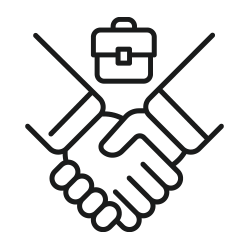
Industry experience
GXO became a standalone company in 2021, but our expertise in logistics innovation dates back decades. We serve a quarter of the Fortune 100 as well as brands in dozens of industries across almost 1,000 facilities around the world.

Tech expertise
Our global technology ecosystem is unrivaled in the industry. As an early adopter of automation, about 40% of GXO operations are automated, compared to an industry average of less than 10%.

Consultative approach
Having led hundreds of successful warehouse implementations, we have an extensive knowledge base, systematized processes and a wealth of data that we’ve turned into insights to benefit our customers.
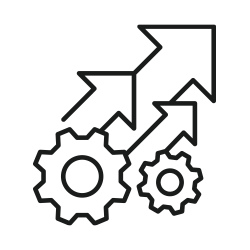
Continuous improvement
We’re always aspiring to better—and we have the technology to make that happen. We incorporate intelligent analytics into logistics operations for data-driven insights that make continuous improvement a reality in real time.
We also adopt a Lean Six Sigma-based approach that is used in manufacturing and deploy these engineering and continuous improvement tenets into how we operate our sites.
Every morning, our teams evaluate how they did yesterday and how they can improve today. This means 130,000 team members across the globe are empowered to identify opportunities to do things faster, more cost effectively or more ergonomically. This transparent, inclusive culture creates an environment of constant innovation that brings continuous improvement to life in real time.
“We don’t say yes for the sake of customer satisfaction. With the knowledge we’ve acquired as the largest pure-play contract logistics company, we can guide clients toward the right solution based on their vertical, size, and unique challenges. We don’t just implement solutions they think they need or want.”
– Nizar Trigui, Chief Technology Officer, GXO
Experience the logistics multiplier effect
Tech-enabled logistics solutions don’t just help you reduce costs, lower workforce constraint risk and drive sustainability—they can fuel growth, transform the way you operate, help you reach consumers in new ways and boost your bottom line.
As we reach a critical inflection point, the time to commit to your logistics transformation strategy is now. To ensure that you can realize your desired outcomes, you’ll need a partner with the experience, expertise, and technology to help you choose the right solutions and implement them correctly the first time—and that’s GXO.
Ready to optimize your supply chain? Let’s talk.
Reach out and we can discuss the right solutions for you based on the unique needs of your business.
